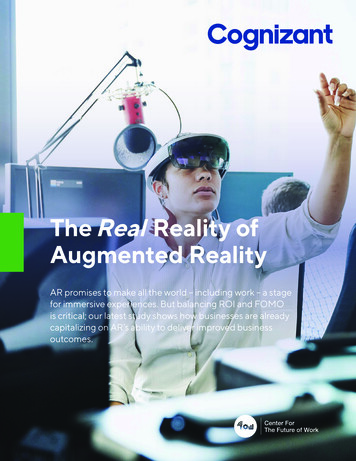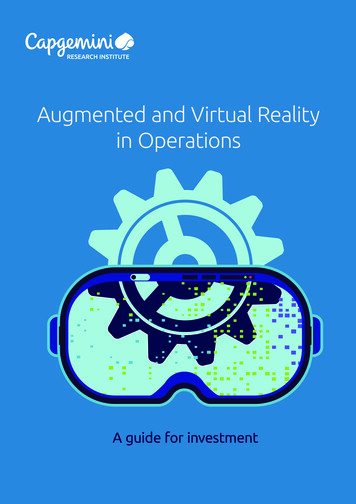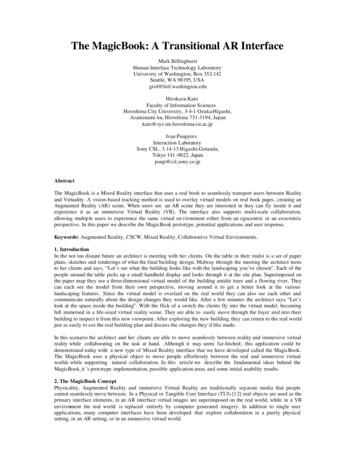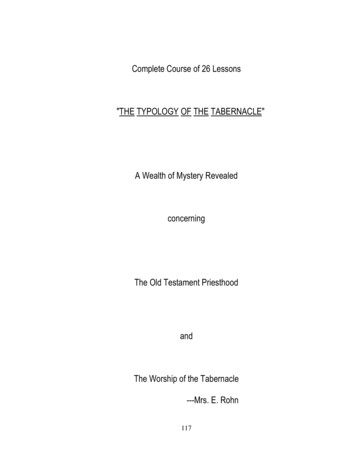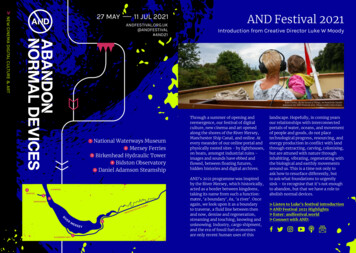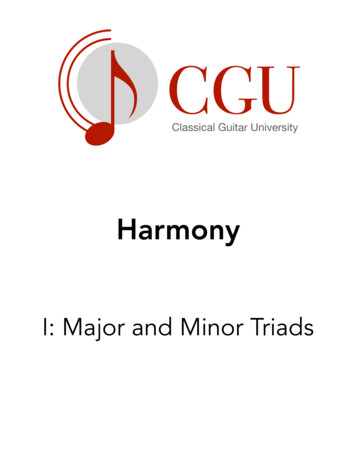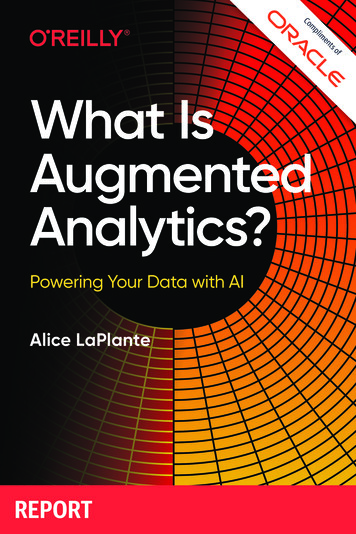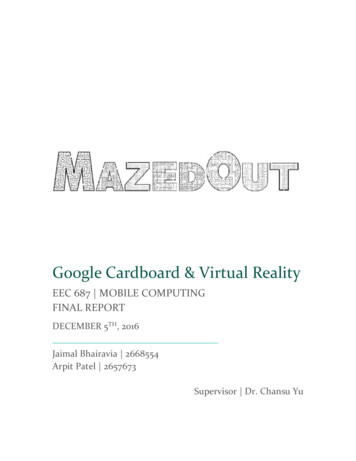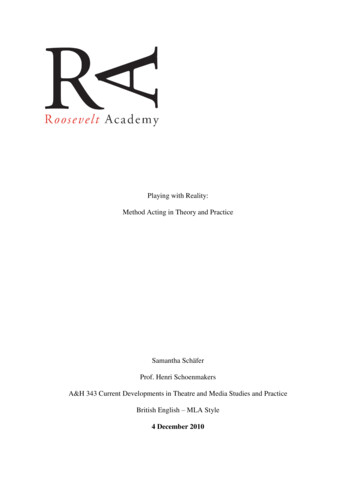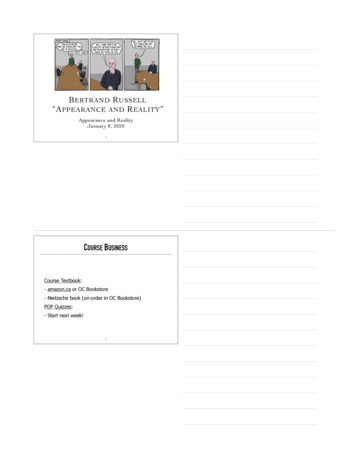
Transcription
283Augmented reality books: concepts, typology, toolsLiubov F. Panchenko1[0000-0002-9979-0625], Tetiana A. Vakaliuk2[0000-0001-6825-4697] andKateryna V. Vlasenko3[0000-0002-8920-5680]1National Technical University of Ukraine “Igor Sikorsky Kyiv Polytechnic Institute”,37 Peremohy Ave., Kyiv, 03056, Ukrainelubov.felixovna@gmail.com2 Zhytomyr Polytechnic State University, 103, Chudnivska Str., Zhytomyr, 10005, Ukrainetetianavakaliuk@gmail.com3 Donbas State Engineering Academy, 7 Academic Str., Kramatorsk, 84313, Ukrainevlasenkokv@ukr.netAbstract. The article discussed the usage of augmented reality books ineducational process. The object of research is augmented reality books. Thesubject of the study is the concepts and classification of augmented reality books;digital story making tools that emphasize child-teacher co-operation; difficultiesin augmented reality using. The methods of research are: the analysis ofpublications about the issue; the analysis of digital tools capabilities;systematization and generalization of research information. In the article the facetclassification for augmented books is proposed; the main facets are: realityvirtuality continuum, type of augmented materials, device types, type ofinteraction, spatial space of book, book’s category. Content for a module of aspecialty course about augmented reality books for the system of professionaltraining and retraining for educators in postgraduate education is discussed. Somesamples of tasks for educators are presented: audio augmented book aboutworld’s books monuments; analysis augmented reality examples in the textbookof the New Ukrainian school (subject name, topic, didactic tasks, quality ofimplementation, directions of expansion etc.), search and analysis augmentedbooks according to the professional interests of the educators; discussion howaugmented reality can help to improve student motivation with accent toattention, relevance, confidence and satisfaction; group work about design andcreation a fragment of own textbook with augmented reality.Keywords: augmented reality, augmented books, classification augmentedreality books, professional training and retraining.1IntroductionAugmented reality allows you to combine the real world with virtual objects, andpossesses vast and diversified didactic learning opportunities. The use of augmentedreality in education has been analyzed by numerous world scientists and Ukrainianresearchers in frameworks of the scientific conferences AREdu 2018 [19], AREdu 2019Copyright 2020 for this paper by its authors. Use permitted under Creative Commons LicenseAttribution 4.0 International (CC BY 4.0).
284[18] and AREdu 2020 [9]; discussed in the massive open online courses [12; 15; 16].A promising area for the use of augmented reality in education is augmented books.We think another important task is to train teachers to create and use these booksduring the educational process.While solving the scientific problem of training educators for using the augmentedreality books in education, the following main results were obtained in past authorworks: the potential of the massive open online courses (MOOCs) about Augmentedreality was investigated, the content and program of the specialized course “AugmentedReality as a Storytelling Tool” for the professional development of teachers wasdescribed [21], the difficulties of using storytelling in education and ways to overcomethem were outlined [22].2Research objective and methodsThe purpose of this article is to explore the definitions of augmented books, theirclassification, and tools. Moreover, tools that can be used by children, students, teachersboth on their own and together with the purpose to use AR books in a module of aspecialized course for the system of professional training and retraining for educatorsin postgraduate education. This module is proposed as the unit of the author'sspecialized course “Digital Storytelling in Adult Education” in the Central Institute ofPostgraduate Pedagogical Education (CIPPE) of State Institution of Higher Education“University of Educational Management” of NAES of Ukraine. The mission of CIPPEis “in providing social and pedagogical requests and needs in quality new professionallevel of pedagogical, scientific and pedagogical and leading personnel of education,public officers, able responsibly and efficiently to execute professional activity inconditions of high competition, instability and permanent changes in professionalenvironment” (http://umo.edu.ua/en/institutes/cippo). Categories of specializedcourse’s listeners are: methodists of district (city) methodical offices or centres andheads of methodical associations; the teachers of academies and universities.The methods of research are: the analysis of the publications on the problem of useaugmented reality in education; the analysis of concepts regarding AR books; theanalysis of software related to augmented reality books; systematization andgeneralization of research information.3Results and discussionAn augmented book represents a “physical or digital copy of a traditional book thatcontains text and illustrations, and which is connected to additional, non-traditionalcontent through the technology of augmented reality” [13]. When a reader accesses thebook page for which additional content is provided, the smartphone or other devicereads it and displays this additional content on the screen. Additional content may bean image, a video or an audio (fig. 1) recording, and can also be complex, such asanimation, game, or interactive activity.
285Fig. 1. Augmented book example in Coursera’s course “Getting start with augmented reality”.Researches place augmented books between virtual and mixed reality books on thecorresponding reality virtuality continuum, presented in the typology: Virtual Book Virtual Augmented book Mixed-Reality book Reality book [13].Мark Billinghurst proposed the magic book concept [6; 7]. The Magic Book use anordinary book as the main interface object. Child can turn the book pages, look at thepictures, and read the text without any additional technology. When children look atthe pages through a handheld Augmented Reality display, they see three dimensionalvirtual models appearing out of the pages. Users can switch between the virtual models.When they see a scene they particularly like, they can fly into the page and experiencethe story as an immersive virtual environment. In the VR mode, users are free to moveabout the scene at will and interact with the characters in the story. Thus, users canexperience the full “Reality-Virtuality continuum”.Мark Billinghurst notes that the Magic Book interface supports collaboration onthree levels [7]:1. as a Physical Object: multiple users can read together;2. as an Augmented Reality Object: users with AR displays can see virtual objectsappearing on the pages of the book;3. as an Immersive Virtual Space: users can fly into the virtual space together and seeeach other represented as virtual avatars in the story space.By Мark Billinghurst, the interface of Magic book supports collaboration on multiplescales. There are egocentric and exocentric view. Egocentrism is the inability todifferentiate between self and other. Readers can fly inside the virtual scenes and seeeach other as virtual characters (egocentric). Exocentric view also allows a nonimmersed reader to see the immersed readers as small virtual characters on the book
286pages. This means that a group of collaborators can share both egocentric andexocentric views of the same game or data set, leading to enhanced understanding [10].Raphael Grasset, Andreas Dünser, Hartmut Seichter and Mark Billinghurst [14]proposed a mixed reality book concept. In this concept the experience with anaugmented book can be defined in terms of the spatial properties of books. The fourelements, which can be explored by a reader are: inside, outside, outside to inside,inside to outside. So, Inside is augmenting the material in the book pages; Outside isaugmenting the space around the pages; Outside to the Inside show interacting from thespace around to the content of the book; Inside to the Outside can extracting contentfrom the book.The author’s prototype of mixed reality book consisted of the book, standard desktopcomputer hardware, a multimodal handheld device, tangible interaction devices (cube,paddles), and an additional green screen. In this prototype with the help of a handhelddevice the user can naturally get immersed into the mixed-reality book. This deviceprovided visual and aural feedback. As prototype the developers chose the book “TheHouse that Jack Built”. This book has contained a lot of images related to the historyof New Zealand, the relationship between Maori and European settlers [14].According to the paper [14], the virtual books are “books completely prepared in anelectronic format and involving minimum physicality. Traditional AR books are usedby adding virtual elements to physical books. Mixed reality books are composed ofvirtual insertions at the meaningful level in the manner most similar to physical books”.Tangible AR interfaces [4; 5] combine the enhanced display possibilities of AR withthe intuitive manipulation and interaction of physical objects or Tangible UserInterfaces. Authors say that experiences with these interfaces show that “the TangibleAR metaphor supports seamless interaction between the real and virtual worlds, andprovides a range of natural interactions that are difficult to find in other AR interfaces”[4]. A Tangible AR interface provides true spatial registration and presentation of 3Dvirtual objects anywhere in the physical environment, while at the same time allowingusers to interact with this virtual content using the same techniques as they would witha real physical object.These are the design principles learned from TUI interfaces: The use of physical controllers for manipulating virtual content.Support for spatial 3D interaction techniques.Support for both time-multiplexed and space-multiplexed interaction.Support for multi-handed interaction.Support for Matching the physical constraints of the object to the requirements ofthe interaction task. The ability to support parallel activity where multiple objects are being manipulated. Collaboration between multiple participants. Authors central hypothesis is that ARinterfaces that follow these design principles will naturally support enhanced faceto-face collaboration [4].Hakan Altinpulluk and Мehmet Kesim [1] analyze augmented reality books ofacademic nature prepared in the field of education through the literature reviewtechnique. They classified 46 augmented books as AR book, augmented desk/paper
287augmentation approach, 3D pop-up book, tangible AR approach and MR book. Authorsdetermined 8 studies as MR books and 38 studies as AR books. The researchers say,that augmented desk/paper augmentation approach and game-based children’s bookscalled interactive 3D pop-up books go away nowadays. The second tendency theynoted, transition from special glasses and head mounted displays to view the books toweb cameras integrated to desktops and mobile devices. Another situation noticed whenanalyzing the studies is that most augmented book studies are not prepared by a singleauthor, and the development of augmented reality books is supported by certainorganizations and collectives.The growing list of books from various authors, platforms, organization, anduniversities, which is being presented to the world community today, raises questionsabout the search and selection of the necessary books, their classification.We have tried to provide a facet classification of digital books, a fragment of whichis shown in table 1.Table 1. Fragment of the facet classification of virtual books.F1VirtualitycontinuumF2Type ofF3augmenDevicested materialF31F11OnlyF21Virtualdesktop orTextBookmobiledevicesF32F12With speF22Mixedcial glasAudioBookses andheadsetsF13AugF23mented VideoBookF14F24Reality 3-D moBook -multiplexed F51and space-mulInsidetiplexed interactionF42Parallel activitywhere multiple objects are being manipulatedF43Collaboration between multiple participantsF44MixedF6CategorybookF7TypeF8interfa- DeveloperceF61F81F71StoryEducational insMarkerbooktitutionF82F62F72F52Binary (EducaText- MarkerOutsidetional institutionbook less organization)F53F63F73OutsideTutori- Projecto insialtiondeF74F54VisualInside F64Initialto out- MapOdosidemetryF65EncyclopediaF83Consortium ofeducational institutionsF84CompanyF85An individual orgroupThe facet classification system, as we know [11; 26; 29], consists of the paralleldivision of a plurality of objects into independent subsets – facets. It is also called the“colon”, the Ranganathan classification. The analysis of scientific sources made it
288possible to present each such augmented book in the form of a structural formula, whichincludes 7 facets. Thus, books can be classified according to the level of virtuality; thetype of augmented content, the types of devices, interaction, spatial space of book,category etc. For example, some augmented book can be described the followingformula:K (F12, F21, F31, F41, F53, F64, F71, F81), where Fij is the i-th focus of the j-th facet.Note that facet classification is easily expanded depending on the book search tasks,for example, within this fragment, we did not knowingly include a subject field; typeof education, free or limited access to book materials etc.The use of AR applications improves motivation of students. One of model ofmotivation design is proposed by John M. Keller [17]. His model [17] divides learnermotivation into four components (attention, relevance, confidence and satisfaction) andcalled ARCS (fig. 2). This model provided strategies for instructors to incorporate eachcomponent into their courses and to choose relevant augmented sfactionFig. 2. Model of motivation design by John M. Keller.Natalia Kucirkova outlines a theoretical rationale of why children’s self-made digitalbooks can be important to their learning and wellbeing, and give practical examples ofhow adults can support children’s digital story-making [20]. She introduces the fiveparameters for children’s personalization: authorship of their own stories, autonomy inproducing them, authenticity of their contribution, attachment to the final product andaesthetics in its creation. She summarized also the key ways in which the teachers useddigital personalized books in their classrooms and proposed the list of question to guidethe children’s activity as storymakers (table 2).Table 2. Question to guide the children’s activity as storymakers [20].Parameters for hmentAuthenticityAestheticsQuestionsTo what extent are the stories based on children’s own content?To what extent was the creation of the final product the child’sindependent work?Who owns the final product?To what extent do children’s stories capture content that isgenuine and responsive to the child’s own situation?To what extent does the final product reflect the child’s own tasteand preference?
289She notes, that depending what digital and human resources are available, children’sdigital story-making can be of 4 types: guided by the teacher or a teacher’s assistant;guided one to one by an older child; collaborative story-making with peers; individualstory-making with an app or digital story-making program.Teachers can combine the various audiences and possibilities for children’s selfmade stories [20]: the whole class with the help of an interactive whiteboard;children’s parents: as printed booklets or e-books emailed to parents;on the screen in a one-to-one with the child’s friend or teacher;on the screen in a small group with the child’s peers;electronically with a remote group of children or distant family members;electronically or, in the case of a classroom visit, in person with a child books authoror illustrator; orally at a classroom assembly with other children, teachers, parents and localcommunity members; the story is not shared and remains the child’s private personal story.Good foundations for creating stories and teaching this area are presented in [8; 28].Fig. 3 shows Story Kitchen from Bruce Van Patter [27]. User can pick one hero, oneplace, and one villain and can read the beginning of history and get to finish it.Fig. 3. Pick Prince, Forest and Wizard: story kitchen from Bruce Van Patter [10].Some other useful applications for Augmented education are: Aumentaty Scope /Aumentary Creator, Wikitude, Quiver Vision / Quiver Education, Star Map / Star ChartAR, Skyview, AR Planet Earth / Geography, 3DBear, CoSpaces Edu, JigSpace,MERGE Cube, Metaverse, Asturica Emerge, Castellones del Ceal AR, Cástulo Virtual,Cisneros Go!, Fuendetodos, La Alhambra - Castillo Rojo, Museo Carlos V and SorollaMuseum AR, Geocaching [24].Natalia Kucirkova [20] analyzes content of popular software for child story making.Some of such resources are presented in table 3. We agree with the author that the finalchoice of the tool remains with the teachers, depending on their skills, inclinations,goals, class situation etc.
290Table 3. Children story making tools.#Name1 StoryJumper2345678Free orNotfree, butpaid forprintedversionfreeBrief DescriptionMay be more useful for US-based teachers,since the community resources offer advicespecifically linked to the Common Corecurriculum.StorybirdStorybird is a platform for writers, readers, andartists of all ages and is a powerful resource forillustrated stories. The illustrations can be usedto inspire children’s own picture books or evennovels with older writers. Story starts withpictures as prompts for children’s own stories.Story MakerfreeStory Maker available on the British Council’swebsite. Children can choose the type of story,props and characters’ names and print the finalstory out. The resource’s focus is on children’slearning of basic English vocabulary.LittleBird free and Little Bird Tales is a subscription site with aTalespaidchoice of a school or home account. Paidoption membership includes the option for children touse their own photos, voiceovers, text anddrawings to make their digital stories.My Storybook freeMy Storybook is suitable for the preschoolersand lower-primary-school children. The userinterface is very child-friendly, with large iconsand pictorial navigation. Final stories can beprinted out as a PDF and stored in a library.Toontastic 3D freeThe Toontastic 3D application is based on storytemplates and pre-designed props andadvertised as a creative storytelling app. Itallows children to create 3D cartoons using theapp’s set of characters, props and backgrounds.The app is managed by Google.Comic Lifefree 30 Comic Life can be used to create comic booksdaysusing one’s own photos. Children’s comics canversion be enhanced with the Comic Life template thatcan add light effects or specific comic themes.Finished stories can be printed out or saved inthe digital library.MITApp freeThe MIT App Inventor initiative at theInventorMassachusetts Institute of Technology allowschildren as evaluate application as well todevelop clife.comappinventor.mit.edu/exploreCriteria for selecting children’s digital books include ordinal criteria and such specificcriteria:
291 relevant enhancements that support narrative;seamless integration of features and enhancements;sound effects that don’t interfere with voiceover or other features;technical polish, stability, ease of use and navigation settings, flexible use;no ads, in-app purchases or links that leave the app (unless under sufficient parentalgate); clearly identified author, illustrator, producer; quality games or other activities that do not interrupt narrative or readingcomprehension [20].The author’s course module “Augmented reality as a tool for storytelling” containsthematic plan of the module; content of the module by themes; lecture and practicalclasses plan; independent work of students; practical tasks for self-control;recommended reading [12]. The thematic module unit about augmented books ispresented in table 4.“Augmented books: concepts and classification” lecture plan.Augmented reality in education. Augmented books. Magic book concept. Mixedreality book concept. Typology of augmented reality books. Facet classification.Interface of Augmented books.“Software and Internet Services about Augmented Reality books” practical trainingplan.Examples of augmented books. Children’s books. Digital stories with augmentedreality. Criteria evaluation of digital books. StoryBird. Story Maker. Story Kitchen.App Inventor.Table 4. Thematic module plan.Thematic module unitAugmented Book concepts and Augmented Bookclassification. Facet classification.Digital books tools for pupils. Digital books toolsfor teachers. Student and teacher co-creation.TotalClass format, hoursIndependentLections PracticesTotalwork1112112124Sample practice tasks for educators:1. create a sample audio augmented book about book monuments of the world(according to the guidelines of course “Getting started with Augmented Reality”)Augmented reality is manifested in the form of the author's accompanying text aboutthe monument of the book, for example for fig. 4. “In Berlin at Bebelplatz on Unterden Linden Boulevard, in front of the Humboldt University building, a twenty-metermonument weighing 35 tonnes was opened, consisting of 17 books by German authors.The sculpture is set in memory of Johann Gutenberg, the inventor of modern printing”.
292Fig. 4. The sculpture is set in memory of Johann Gutenberg, the inventor of modern printing:17 books by German authors (https://lesoteka.livejournal.com/78147.html).2. analyze augmented reality examples in the textbook (fig. 5) of the New Ukrainianschool (subject name, topic, didactic tasks, quality of implementation, directions ofdevelopment etc.);Fig. 5. Augmented reality example in the textbook of New Ukrainian school(https://www.youtube.com/watch?v rWLWkKkV1SQ).3. find and analyze some augmented books according to the professional interests ofthe student;4. discuss how augmented reality can help to improve student motivation: attention,relevance, confidence and satisfaction;5. group work: design and create a fragment of their own textbook with augmentedreality.We also think that the use of AR technology will facilitate the co-creation of studentsand teachers. We understand co-creation [23; 24; 25] as a joint creative activity of a
293teacher and a student, aimed at developing the educational environment and ourselvesin this environment.The scientist’s research of difficulty to use AR is presented in [2]. Julio BarrosoOsuna, Juan Jesús Gutiérrez-Castillo, Mª del Carmen Llorente-Cejudo and RubiceliaValencia Ortiz present, that experts pointed out what might present the most difficulty: lack of teacher training;lack of educational experience;lack of conceptual foundation;lack of educational research;institutional difficulty / lack of institutional support.In our research [22] we study the problem of the use of storytelling technology ineducational process. According to the survey of teaching staff and methodologists ofdifferent professions while they were taking retraining courses, only a quarter ofrespondents use or have used this method, and about 72% of respondents are ready toconsider it. A 3-factor model on possible barriers that impede the use of digitalstorytelling in education was developed on the basis of the empirical data with the helpof a factor analysis tool. The first factor was related to the lack of necessary resources,the second one – to resistance to change, the third one – to the lack of time and lack oftechnical and methodological support from the educational institution. As we see, thelast factor is the same as in research [2].What are possible ways to overcome these barriers? According to some scholars[30], an inappropriate level of professional development can also be a barrier to the useof information technology in general and digital staging in particular. Peter G. Taylorproposes a strategy for engaging a critical mass of staff in a technology-augmentededucational practice and identifies 5 required steps: orientation, acceptance, evaluation,innovation, and institutionalization for professional development programs [30,pp. 275–276]. Let's look at these steps in more detail, with a focus on using AR books.At the orientation stage, teachers are considering approaches to integratingaugmented reality technologies into teaching and learning that meet current educationalexpectations, technology availability, and the requirements of the educationalinstitution's curriculum and the subject matter they teach. During the adoption phase,educators adapt current intentions and practices to teaching and learning usingaugmented technology in a high-tech learning environment. They then evaluate thesepractices (evaluation phase). In the next phase, innovators and educators re-developtheir practice based on their own experience of digital story technology in a high-techenvironment of the educational institution and study the reactions of the educationalrecipients to them. At the institutionalization stage, educators and managers developstrategies to ensure that new teaching and learning methods are maintained in themedium and long term and thus become “traditional”.The first three phases (orientation, acceptance, assessment) – we relate to the firstperiod of teachers training and retraining, which is full-time; the fourth phase(innovation) – with the inter-course period of teacher training and retraining; the fifthphase (institutionalization) – partly with the third period of teacher training, which isalso full-time and with course work’s presentation. We agree with Peter G. Taylor that
294each of these stages requires different approaches to professional development andshould include time for reflection, specific training, discussion, consideration ofalternative practices, and transformation of accepted practices. We consider it important- the organization of pedagogical support for teachers in these areas.It would be interesting to apply Zane L. Berge, Lin Y. Muilenburg and James VanHaneghan [3] methodology (they studied barriers in distance learning) to the study ofdifficulties in using AR in education.Note that recently there have been special programs that train specialists inaugmented and virtual reality.So, for example, Singapore University of Social Sciences offers a three-yearprogram Virtual Reality and Augmented Reality (MTD369) [31]. The content of thefirst two years of preparation is shown in fig. 6. This list of courses gives an idea of thediverse training of specialists. We can take note of such courses as creativity andimagination, storytelling, narratives and experience for training teachers in thisdirection.Fig. 6. VR Program and AR Program in Singapore University of Social Sciences [31].4ConclusionsThus, the augmented reality can provide modern education with new didacticmeasurements and tools at the teacher and student level, contribute to a betterunderstanding of complex topics, visualize hidden processes, and so make it acceptablefor adults and people with disabilities. An augmented textbook is a new educationaltool, it can contain fragments of video lectures, electronic pads such as Padlet,augmented quizzes, 3D models, animated tours in the history of the problem beingstudied, in-depth exercises, didactics games etc.The facet classification of augmented reality books is offered on the basis of the
295analysis of the scientific sources about these books. The main facets are: realityvirtuality continuum, type of augmented material, devices, type of interaction, spatialspace of book, book’s category. The author's specialized course “Digital Storytelling inAdult Education” for the system of professional training and retraining of educators isupdated with augmented book creation module.The further development of the study is seen in the didactics analysis of the newapps for creating augmented textbook, clarification of the facet classification proposedand detail learning of barriers in the use of augmented reality in education, inparticularly, by methodology of Zane L. Berge, Lin Y. Muilenburg and James VanHaneghan uk, H., Kesim М.: The Classification of Augmented Reality Books: A LiteratureReview. In: INTED2016 10th International Technology, Education and DevelopmentConference Proceedings, Valencia, Spain, 7-9 Мarch 2016, pp. 4110–4118 (2016).doi:10.21125/inted.2016.0200Barroso Osuna, J., Gutiérrez-Castillo J.J., del Carmen Llorente-Cejudo, M., Valenica Ortiz,R.: Difficulties in the Incorporation of Augmented Reality in University Education: Visionsfrom the Experts. Journal of New Approaches in Educational Research 8(2), 126–141(2019). doi:10.7821/naer.2019.7.409Berge, Z., Muilenburg, L., Van Haneghan, J.: Barriers to distance education and training.Quarterly Review of Distance Education 3(4), 409–419 (2002)Billinghurst, M., Kato, H., Poupyrev, I.: Collaboration with tangible augmented realityinterfaces. http://citeseerx.ist.psu.edu/viewdoc/download?doi 10.1.1.98.766&rep rep1&type pdf (2002). Accessed 16 Apr 2020Billinghurst, M., Kato, H., Poupyrev, I.: Tangible Augmented Reality. Communications ofthe ACM 45(7) (2003). doi:10.1145/514236.514265Billinghurst, М., Kato, H., Poupyrev, I.: The MagicBook: a transitional AR interface.Computers & Graphics 25(5), 745–753 (2001). doi:10.1016/S0097-8493(01)00117-0Billinghurst, М.: Augmented Reality in Educat
the story as an immersive virtual environment. In the VR mode, users are free to move about the scene at will and interact with the characters in the story. Thus, users can experience the full “Reality-Virtuality continuum”. Мark Billinghurst notes that the Magic B
